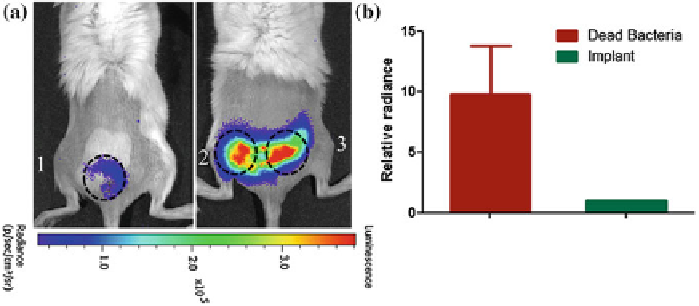Biomedical Engineering Reference
In-Depth Information
Fig. 5
In vivo imaging of Interferon-
β
production in response to bacteria: Bioluminescent imaging
was done after implantation and luciferin injection (
a
). Implants are as follows:
1
Titanium implant,
2
and
3
Heat inactivated bacteria. The relative radiance was calculated and the radiance of the
control implant was arbitrarily set to 1 (
b
)
3.4 Visualizing Innate Immune Responses
The interferon-
gene can be activated by various infectious pathogens such as viruses
or bacteria. To visualize interferon-
β
gene activity transgenic reporter mice were
used [
32
]. A biocompatible titanium implant was implanted subcutaneously and
to induce an inflammatory response titanium implants coated with heat inactivated
bacteria were used. Signals frombacteria were readily detected after a short delay of a
few hours and remained detectable for more than 24h (Fig.
5
a). Inflammatory signals
induced by bacteria were 10-fold higher when compared to the bare titanium implant
(Fig.
5
b). Therefore, with this assay we could clearly and reproducibly detect and
localize bacteria while uninfected control implants did not give a detetcable signal
(Fig.
5
a).
β
4 Discussion
We have attempted to establish a method to distinguish and evaluate the inflamma-
tory potential of implant materials. For this purpose, we used different fluorescent
reporter molecules and luminescent transgenic reporter animals. It was first attempted
to apply hydrocyanines intravenously but the resulting fluorescence intensity was be-
low the detection limit (data not shown). Therefore, the dye was applied directly at
implantation site. The inflammation associated oxidation potential increased in re-
sponse to bacterial components over the time period investigated. Implantation of
biocompatible glass also induced some minor degree of ROS activity which was
comparable to surgery without implantations suggesting a response caused by injury

